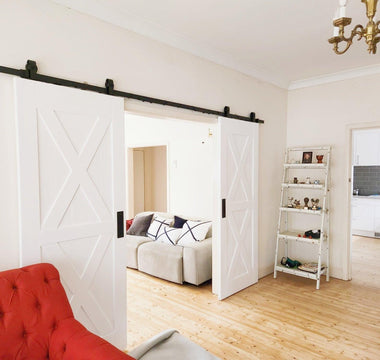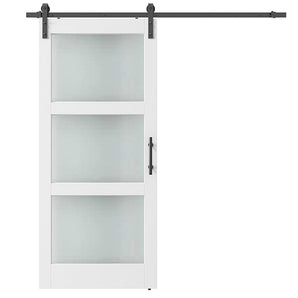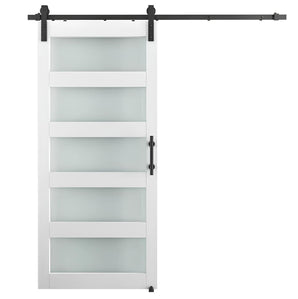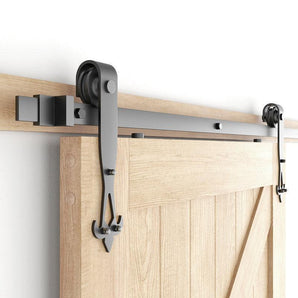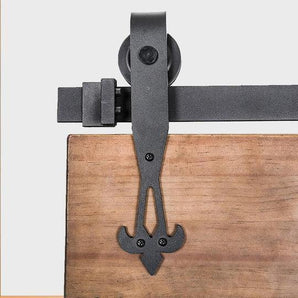## Introduction to barn doors
Barn doors have become increasingly popular in recent years, not only for their rustic charm but also for their space-saving functionality. Whether you're looking to add a touch of farmhouse style to your home or seeking a unique solution for separating rooms, barn doors offer a versatile and stylish option. One crucial aspect to consider when choosing a barn door is its width dimensions. In this comprehensive guide, I will take you through everything you need to know about selecting the right width dimensions for your barn door.
Why width dimensions are important for barn doors

The width dimensions of a barn door play a vital role in its functionality and aesthetics. A barn door that is too narrow may not provide enough coverage, compromising privacy and reducing its effectiveness as a room divider. On the other hand, a door that is too wide can be cumbersome to open and close, defeating the purpose of a space-saving solution. Therefore, it is essential to carefully consider the width dimensions to ensure your barn door serves its purpose effectively while enhancing the overall look and feel of your space.
Factors to consider when choosing the right width dimensions

When selecting the width dimensions for your barn door, several factors need careful consideration. Firstly, you should evaluate the available space where the door will be installed. Measure the width of the doorway or wall opening accurately to determine the maximum width the door can be. Additionally, consider the overall design aesthetic of the room. A wider door may work better in a spacious room with high ceilings, while a narrower door can be more suitable for a smaller, cozy space.
Another crucial factor to consider is the function of the barn door. If you're using it as a room divider, you'll need to ensure the width dimensions provide enough coverage to create a sense of separation. However, if you're installing the door purely for aesthetic purposes or to cover a storage area, you have more flexibility in choosing the width dimensions. Lastly, keep in mind any building codes or regulations that may dictate the minimum or maximum width dimensions for certain applications.
Standard width dimensions for barn doors

While there is no one-size-fits-all solution when it comes to barn door width dimensions, there are some standard measurements that can serve as a starting point. Standard barn doors typically range from 36 to 48 inches in width. A 36-inch door is suitable for smaller openings, such as closets or pantries, while a 48-inch door is more commonly used for larger openings, such as entryways or living spaces. It's important to note that these dimensions can vary depending on the manufacturer, so always double-check the specifications before making a purchase.
Customizing width dimensions for your barn door

If the standard width dimensions don't meet your requirements or if you're looking for a more unique and personalized look, customizing the width dimensions of your barn door is a great option. Many manufacturers offer customization services, allowing you to choose the exact width that fits your space perfectly. Customizing your barn door also opens up a world of design possibilities, as you can select from a wide range of materials, finishes, and barn door hardware options to create a door that complements your interior style seamlessly.
When customizing the width dimensions, it's important to keep in mind the practicality of the door. While a wider door may look impressive, it could be challenging to maneuver in tight spaces. On the other hand, a narrower door might not provide adequate coverage. Take into account the specific needs of your space and consult with professionals if necessary to ensure the custom width dimensions strike the right balance between functionality and aesthetics.
Measuring and calculating the ideal width dimensions

Accurate measurement is crucial when determining the ideal width dimensions for your barn door. Start by measuring the width of the doorway or wall opening at multiple points, as walls are often not perfectly straight. Take the smallest measurement as the width for your door to ensure a proper fit. Next, consider any additional factors that may affect the clearance needed, such as baseboards or trim. These factors should be taken into account when calculating the final width dimensions.
To calculate the ideal width for your barn door, add a few inches to the measured width to allow for proper coverage and clearance. This additional width will ensure that the door fully covers the opening and provides privacy when closed. However, be careful not to add too much extra width, as this can make the door too heavy and difficult to operate. It's always a good idea to consult with a professional or refer to manufacturer guidelines to determine the appropriate amount of additional width to add.
Popular width dimensions for different applications

The ideal width dimensions for your barn door will largely depend on the specific application. Here are some popular width dimensions for different scenarios:
-
Closet doors: For standard closet doors, a width of 36 inches is commonly used. This width provides ample coverage while allowing easy access to the closet space.
-
Pantry doors: Pantry doors typically have a width of 30 to 36 inches. This narrower width ensures that the door doesn't take up too much space while still providing convenient access to the pantry.
-
Entryway doors: For larger openings such as entryways or living spaces, wider barn doors ranging from 42 to 48 inches are often used. These wider doors create a grand entrance and make a bold statement in the room.
-
Room dividers: When using a barn door as a room divider, the width dimensions should be determined based on the size of the space you want to separate. For smaller areas, a width of 30 to 36 inches may be sufficient, while larger rooms may require a wider door of 48 inches or more.
Remember, these are just general guidelines, and you should always consider the specific requirements of your space when choosing the width dimensions for your barn door.
Common mistakes to avoid when choosing width dimensions

Choosing the right width dimensions for your barn door can be a daunting task, especially with so many factors to consider. To help you make an informed decision, here are some common mistakes to avoid:
-
Not measuring accurately: Accurate measurement is crucial when determining the width dimensions. Failing to measure properly can result in a door that doesn't fit or doesn't provide adequate coverage.
-
Neglecting clearance requirements: For the door to operate smoothly, it's important to consider the clearance needed. Failure to account for baseboards, trim, or any other obstacles can lead to a door that doesn't open or close properly.
-
Ignoring the space limitations: It's crucial to consider the available space where the door will be installed. Choosing a door that is too wide for a small space or too narrow for a large space can negatively impact the functionality and aesthetics.
-
Not consulting professionals: If you're unsure about the ideal width dimensions or if your space has unique requirements, it's always a good idea to consult with professionals. They can provide valuable insights and help you make the right decision.
By avoiding these common mistakes, you can ensure that your barn door fits perfectly and functions as intended.
Hiring a professional to help with width dimension selection
If you're feeling overwhelmed or unsure about choosing the right width dimensions for your barn door, don't hesitate to seek professional assistance. Hiring a professional can provide you with peace of mind, knowing that the dimensions are carefully calculated and the door will fit perfectly within your space. Professionals have the expertise and experience to consider all the necessary factors and guide you towards making the best decision for your specific needs.
Conclusion and final tips for choosing the right width dimensions for your barn door
Selecting the right width dimensions for your barn door is essential for achieving both functionality and aesthetics. By carefully considering factors such as available space, room design, and specific application, you can determine the ideal width dimensions that meet your needs. Whether you opt for standard dimensions or choose to customize your barn door, accurate measurement and careful calculation are key. By avoiding common mistakes and seeking professional assistance if needed, you can ensure a barn door that fits perfectly and enhances the overall look and feel of your space.
Remember, your barn door is a significant investment, and selecting the right width dimensions is crucial to its overall success. Take the time to evaluate your options, consider the specific requirements of your space, and consult with professionals when necessary. With the right width dimensions, your barn door will not only be a functional and space-saving solution but also a stunning focal point in your home.


